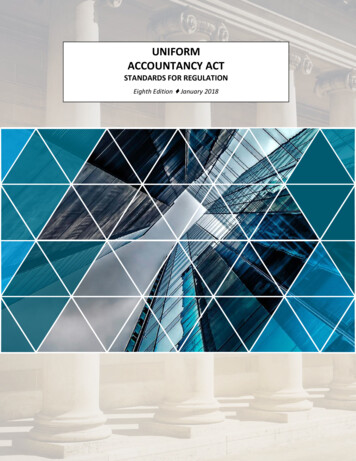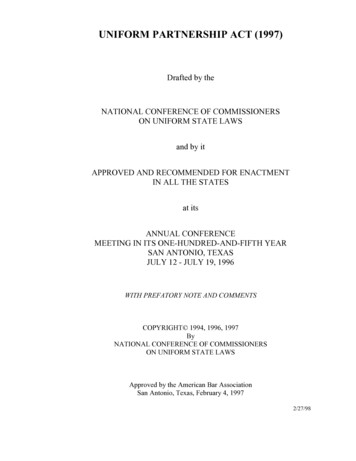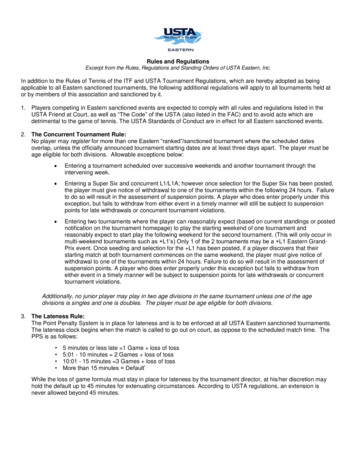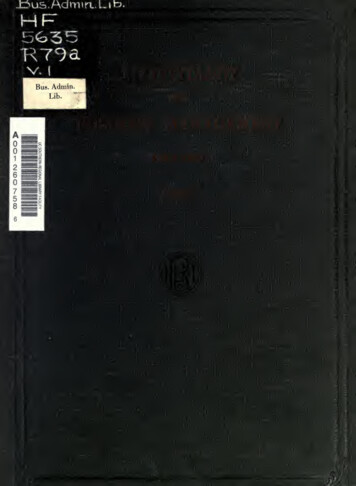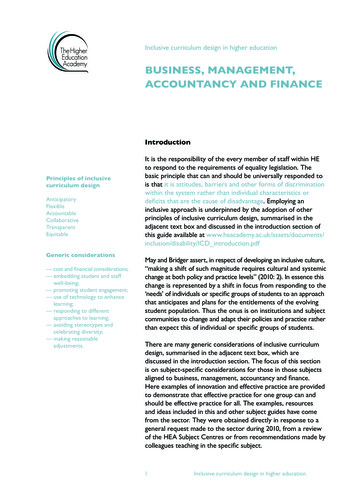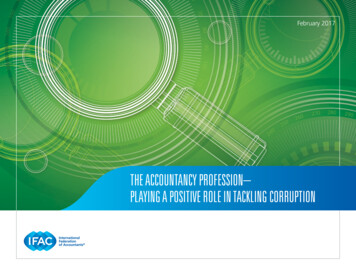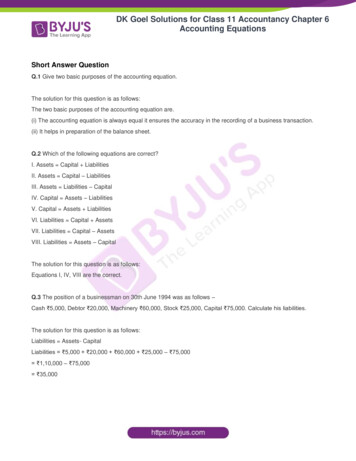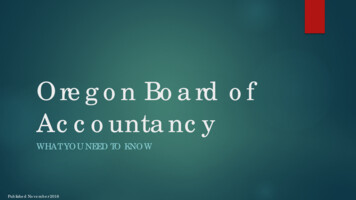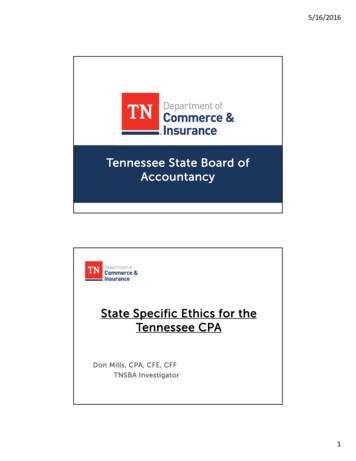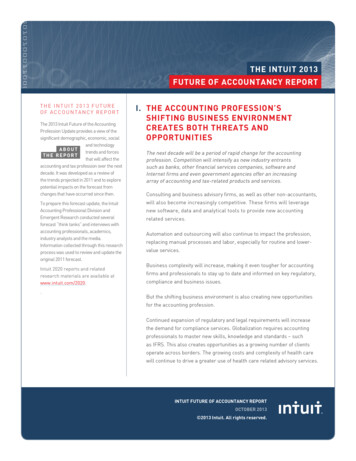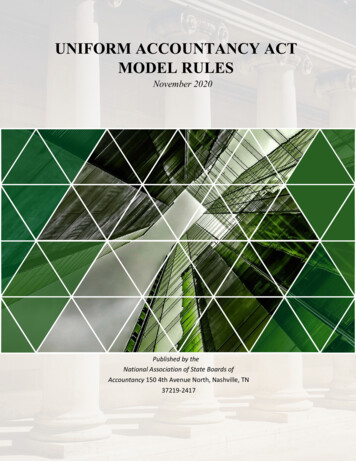
Transcription
UNIFORM ACCOUNTANCY ACTMODEL RULESNovember 2020Published by theNational Association of State Boards ofAccountancy 150 4th Avenue North, Nashville, TN37219‐2417
Copyright 2020National Association of State Boards of Accountancy150 4th Avenue, North, Suite 700, Nashville, TN 37219-2417All rights reserved. For information about the procedure for requesting permission to makecopies of any part of this work, please contact the NASBA at NASBA-UAA@nasba.org.Otherwise, requests should be written and mailed to the Rights and Permissions Department,NASBA-UAA, 150 4th Avenue, North, Suite 700, Nashville, TN 37219-2417.1 2 3 4 5 6 7 8 9 0 SR 9 9 8
UNIFORM ACCOUNTANCY ACT MODEL RULESTable of ContentsINTRODUCTORY COMMENTS . Rules-I-5PREAMBLE. Rules-Pre-1Rule. Page3-13-23-33-43-53-63-73-83-93-10ARTICLE 3 - DEFINITIONSTerms used in these rules . 3-1Agreed upon procedure. 3-1Audit . 3-1Professional engagement . 3-2Continuing Professional Education . 3-2CPE reporting period . 3-2Subject matter expert . 3-2Technical committee . 3-2Technical fields of study . 3-2Non-technical fields of study . 3-34-6ARTICLE 4 - STATE BOARD OF ACCOUNTANCYBoard meetings . 4-1Election and tenure of officers . 4-1Duties of officers . 4-1Fees . 4-1Obligation of licensees to notify the Board of changes of address andother information . 4-2Communications . 4-25-15-25-25-35-45-55-65-75-85-95-105-11ARTICLE 5 - CERTIFIED PUBLIC ACCOUNTANTSEducation requirements - definitions . 5-1Education requirements – determining compliance of the applicant’seducation. 5-2Applications for examination . 5-5Time and place of examination. 5-6Examination content. 5-6Determining and reporting examination grades. 5-6Retake and granting of credit requirements . 5-6Candidate testing fee . 5-7Cheating . 5-7Security and irregularities . 5-9Good moral character . 5-96-1ARTICLE 6 - ISSUANCE OF CERTIFICATES AND RENEWAL OFCERTIFICATES AND REGISTRATIONS, CONTINUINGPROFESSIONAL EDUCATION AND RECIPROCITYApplications . 6-14-14-24-34-44-5Rules TOC-i
7-77-87-97-10Experience required for initial certificate . 6-1Evidence of applicant's experience . 6-1Continuing professional education requirements for renewal orreactivation of a certificate, license or registration . 6-2Activities qualifying for continuing professional education credit . 6-4Continuing professional education records . 6-6CPE reciprocity. 6-8Exceptions. 6-9Interstate practice . 6-10International reciprocity . 6-11Peer review for certificate holders who do not practice in a licensed firm . 6-12ARTICLE 7 - PERMITS TO PRACTICE -- FIRMSApplications . 7-1Notification of firm changes. 7-1Peer review definitions . 7-2Enrollment in board-approved peer review program. 7-3Submission of peer review documents . 7-4Approved peer review sponsoring organizations, programs and peer reviewstandards . 7-5Peer review oversight committee . 7-6Internet practice. 7-7Attest documentation and retention . 7-7Unregistered firm compliance with applicable peer review documentationrequirements . 7-710-110-210-3ARTICLE 10 - ENFORCEMENT ACTIONS AGAINST LICENSEESGrounds for enforcement actions against licensees . 10-1Return of certificate, registration or permit to practice . 10-3Applicable standards . 10-311-111-211-3ARTICLE 11 - ENFORCEMENT PROCEDURES -- INVESTIGATIONSReview of professional work product . 11-1Reporting convictions, judgments, and administrative proceedings . 11-1Participation in multistate enforcement compacts . 11-313-113-2ARTICLE 13 - REINSTATEMENTApplications for relief from disciplinary penalties . 13-1Action by the Board . 13-114-114-2ARTICLE 14 - UNLAWFUL ACTSCPA firm names. 14-1Safe harbor language. 14-323-123-2ARTICLE 23 - SUBSTANTIAL EQUIVALENCYSubstantial equivalency and internet practice . 23-1Practice in other states through substantial equivalency. 23-1Rules TOC-ii
23-323-3Reporting moral character violations . 23-1Continuing professional education requirements for practice privileges . 23-1Rules TOC-iii
Uniform Accountancy ActModel RulesNational Association of State Boards of Accountancy
Introductory CommentsThese Uniform Accountancy Rules (“Rules”) have been prepared by the NationalAssociation of State Boards of Accountancy (“NASBA”) as part of its continuing effort toupdate and promote uniformity in the regulatory schemes governing the practice ofaccountancy in the various jurisdictions.These Rules are keyed to the Uniform Accountancy Act (“Uniform Act”) – EighthEdition in several respects. Like most rules of administrative agencies they are intendedin a general sense to implement or to explain specific statutory provisions governing theoperations of the agency concerned; thus, in those cases where it appears appropriate fora Rule to contain a reference to a statutory provision, the reference provided in theseRules is to a provision of the Uniform Act. The organizing pattern of the Rules alsoreflects that of the Uniform Act: the numbered Articles under which the Rules aregrouped correspond to section numbers in the Uniform Act.The Rules are not intended to depend entirely upon the Uniform Act, or to besuitable for adoption only in jurisdictions where the accountancy law corresponds to theUniform Act. Where the law that is in force varies from the Uniform Act, modificationsmay be necessary to adapt the Rules to the pertinent statute.Rules Intro
PreambleThese Rules are adopted by the Board of Accountancy, pursuant to itsauthority under the [Public] Accountancy Act of 20 . Their purpose is to promote andprotect the public interest by implementing the provisions of that Act, which provide forthe issuance and renewal of certificates as certified public accountants; the renewal ofregistrations to public accountants; the issuance and renewal of permits to firms; and theregulation of licensees, all to enhance the reliability of information which is used forguidance in financial transactions or accounting for or assessing the financial status orperformance of commercial, noncommercial and governmental enterprises.Rules - Pre
ARTICLE 3DEFINITIONSRule 3-1 - Terms used in these rules.For purposes of these Rules the following terms have the meanings indicated:(a)“Act” means the [Public] Accountancy Act of ,[statutory reference].(b)“Financial statements” means statements and footnotes related thereto thatundertake to present an actual or anticipated financial position as of a point intime, or results of operations, cash flow, or changes in financial position for aperiod of time, in conformity with Generally Accepted Accounting Principles oranother comprehensive basis of accounting. The term does not include incidentalfinancial data included in management advisory service reports to supportrecommendations to a client; nor does it include tax returns and supportingschedules.(c)For purposes of the definition of "attest" as provided in Section 3(b) of the Act, theBoard adopts and incorporates by reference:(1)(2)Each of the following as issued by the AICPA and including subsequentamendments and editions:(A)The Statements on Auditing Standards (SAS),(B)The Statements on Standards for Accounting and Review Services(SSARS), and(C)The Statements on Standards for Attestation Engagements (SSAE);The standards and rules adopted by the PCAOB including subsequentamendments and editions.COMMENT: This is the adoption by reference required by UAA 3(b). This adoption is inaddition to “applicable standards” set forth in Rule 10-3. Caution: Some jurisdictions haveconstitutional or statutory restrictions limiting or prohibiting evergreen adoptions by reference,and require that only specific, dated versions of standards be adopted.Rule 3-2 – Agreed upon procedure.An “agreed-upon procedures engagement” is one which is to be performed in accordancewith applicable attestation standards and is one in which a licensee is engaged to issue awritten finding(s) that (i) is based on specific procedures that the specified parties agreeare sufficient for their purposes, (ii) is restricted to the specified parties, and (iii) does notprovide an opinion or negative assurance.Rule 3-3 - Audit.“Audit” means the procedures performed in accordance with applicable auditingstandards for the purpose of expressing or disclaiming an opinion on the fairness withwhich the historical financial information is presented in conformity with GenerallyRules 3-1
Accepted Accounting Principles, another comprehensive basis of accounting, or a basis ofaccounting described in the report.Rule 3-4 – Professional engagement."Professional engagement" means an agreement between a client and a licensee relativeto the performance of professional services and the services performed under thisagreement.Rule 3-5 – Continuing Professional Education (CPE).Continuing Professional Education (CPE) is an integral part of the lifelong learningrequired to provide competent service to the public. It is the set of activities that enablesCPAs to maintain or improve their professional competence.Rule 3-6 – CPE reporting period.A “CPE reporting period” is the period of time as to which a licensee in this State mustreport or attest to the completion of CPE requirements to the Board of Accountancy.Rule 3-7 - Subject matter expert.A “subject matter expert” is a person who is an authority in a particular area or topic. Asubject matter expert is involved in developing CPE materials where knowledge expertiseis needed.Rule 3-8 - Technical committee.A “technical committee” is a committee that serves as a resource to identify issuesregarding the practice of accountancy and develop technical or policy recommendationson those issues.Rule 3-9 - Technical fields of study.“Technical fields of study” are technical subjects that contribute to the maintenanceand/or improvement of the competence of a CPA in the profession of accountancy andthat directly relate to the CPA’s field of business. These fields of study include, but arenot limited to:(a)Accounting;(b)Accounting (Government);(c)Auditing:(d)Auditing (Government);(e)Business Law;Rules 3-2
(f)Economics;(g)Finance;(h)Information Technology;(i)Management Services;(j)Regulatory Ethics;(k)Specialized Knowledge;(l)Statistics; and(m)Taxes.COMMENT: The technical subjects are further defined in the “Fields of Study” document, aspublished on NASBA’s website, www.nasbaregistry.org, and included in the “Statement onStandards for Continuing Professional Education (CPE) Programs,” appended to the UniformAccountancy Act. The “Fields of Study” document provides descriptions of each technicalsubject area and examples of the types of topics that might be included in each area.Rule 3–10 – Non-technical fields of study.“Non-technical fields of study” are subjects that contribute to the maintenance and/orimprovement of the competence of a CPA in areas that indirectly relate to the CPA’s fieldof business. These fields of study include, but are not limited to:(a)Behavioral Ethics;(b)Business Management & Organization;(c)Communications and Marketing;(d)Computer Software & Applications;(e)Personal Development;(f)Personnel/Human Resources; and(g)Production.COMMENT: The non-technical subjects are further defined in the “Fields of Study” document,as published on NASBA’s website, www.nasbaregistry.org, and included in the “Statement onStandards for Continuing Professional Education (CPE) Programs,” appended to the UniformAccountancy Act. The “Fields of Study” document provides descriptions of each non-technicalsubject area and examples of the types of topics that might be included in each area.Rules 3-3
ARTICLE 4STATE BOARDS OF ACCOUNTANCYRule 4-1 – Board meetings.The Board shall meet at least times each year. The chair or a quorum of the Boardshall have the authority to call meetings of the Board. The Board shall follow and applythe rules of procedure, [statutory reference], as regards notice andconduct of meetings.Rule 4-2 – Election and tenure of officers.The Board shall elect annually from among its members a chair, a vice-chair, and suchother officers as the Board may require. The officers shall assume the duties of theirrespective offices at the conclusion of the meeting at which they were elected. They shallserve a term of one year, but shall be eligible for reelection.Rule 4-3 – Duties of officers.The chair or, in the event of the chair’s absence or inability to act, the vice-chair shallpreside at all meetings of the Board. The Board shall determine other duties of the officers.Rule 4-4 – Fees.Fees charged by the Board shall be as follows:(a)Examination applications (b)Administration of examination, per section (c)Initial issuance of certificate (d)Renewal of certificate or registration (e)Initial firm permits (f)Renewal of firm permits, except for sole practitioners (g)Renewal of firm permits for sole practitioners (a)Delinquency fee for permit, certificate or registration renewalapplications (i)Copies of records, per page (j)Applications for reinstatement (k)Annual reports of the Board, per copy Rules 4-1
(l)Other fees (The Board may charge other fees as required) Rule 4-5 - Obligation of licensees to notify the Board of changes of address and otherinformation.Each licensee shall notify the Board in writing within thirty (30) days of any change ofaddress or, in the case of individual licensees, change of employment.Rule 4-6 - Communications.A licensee or anyone using practice privileges pursuant to Sections 7 or 23 of the Act shallrespond in writing to any registered or certified communication from the Boardrequesting a response. Unless otherwise specified in the Board’s communication, theresponse must be sent within thirty (30) days of the date of such communication.Rules 4-2
ARTICLE 5CERTIFIED PUBLIC ACCOUNTANTSRule 5-1 - Education requirements – definitions.(a)“Semester credit hour” (SCH) means the conventional college semester credithour. “Quarter credit hours” may be converted to semester credit hours bymultiplying them by two-thirds; i.e., one quarter credit hour equals two-thirds ofa semester credit hour.(b)“College(s) or university(ies)” means Board-recognized institution(s) of highereducation accredited by Board-recognized accrediting organizations.(c)“Accredited” or “Accreditation” reflects the quality control of the educationprocess provided by Board-recognized accreditation organizations. In determiningacceptable accreditation organization, the Board may recognize a Council forHigher Education (CHEA) recognized accreditation organization. These Rulesrefer to three levels of accreditation. Level 1 represents the most comprehensivereview at the accounting program level and Level 3 is the least comprehensivereview at the college or university level. Colleges or universities withoutaccreditation, as defined below, would generally
Standards for Continuing Professional Education (CPE) Programs,” appended to the Uniform Accountancy Act. The “Fields of Study” document provides descriptions of each technical subject area and ex
